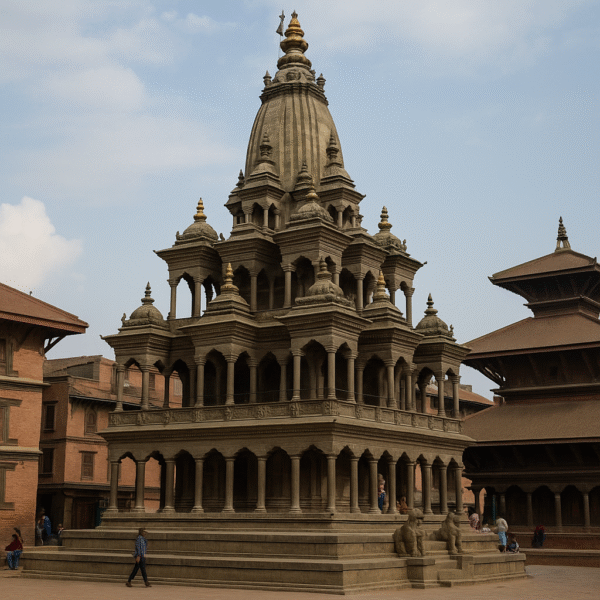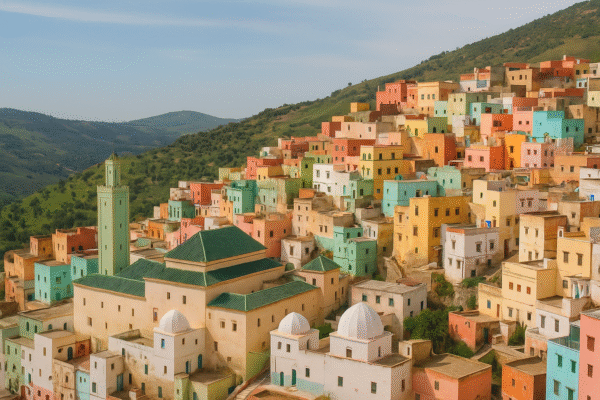Krishna Mandir in Patan: Nepal’s Restored Heritage Treasure
In the heart of Patan Durbar Square, a UNESCO World Heritage site in Lalitpur, the Krishna Mandir stands once again in full splendor after years of meticulous restoration. Built entirely from stone in the 17th century by King Siddhi Narsingh Malla, this three-storied Shikhara-style temple is considered one of Nepal’s most significant architectural landmarks.
Unlike most temples of its era, which were constructed from wood and brick, Krishna Mandir is carved entirely from stone, showcasing the craftsmanship and ingenuity of Newar artisans during the Malla period. Its towering spire, delicate arcades, and intricately designed chhatris make it a masterpiece of medieval Nepalese architecture.
A Restoration of Historic Importance
The devastating earthquake of 2015 caused significant structural damage to the Krishna Mandir, particularly to its upper floors and intricate stone elements. The restoration, led by the Kathmandu Valley Preservation Trust, brought together skilled local artisans, engineers, and heritage experts. Traditional Newar stone-carving techniques were used alongside modern seismic reinforcement methods, ensuring both authenticity and resilience.
Large stone blocks—some weighing over 700 kilograms—were carefully realigned and reset. Damaged cornerstones, supporting pillars, and decorative carvings were reconstructed with remarkable attention to historical accuracy. This painstaking process took several years, with artisans from Patan and Bhaktapur contributing their expertise to preserve the temple’s original character.
By the time the work was completed, the Krishna Mandir was ready to welcome visitors once again, restored to its former grandeur while fortified to withstand future earthquakes.
Architectural Brilliance
Krishna Mandir is an early example of the Shikhara style in Nepal—an architectural form more common in northern India. The three tiers of the temple are adorned with finely carved stone columns and beams depicting scenes from the Mahabharata and Ramayana, including the ten avatars of Lord Vishnu.
The temple’s two-bay colonnaded ambulatory provides a sense of lightness to its otherwise monumental structure. The upper levels, which house shrines dedicated to Lord Shiva and Lokeshwor, illustrate the religious harmony that characterizes the Kathmandu Valley, blending Hindu and Buddhist traditions in a single sacred site.
Spiritual and Cultural Significance
Krishna Mandir remains a vibrant center of worship, particularly during the festival of Janmashtami, which celebrates the birth of Lord Krishna. On this occasion, devotees gather in large numbers, chanting hymns, lighting oil lamps, and offering prayers well into the night. The temple becomes a glowing beacon of devotion, visible from across Patan Durbar Square.
Although the main sanctum is reserved for Hindus, the temple’s outer corridors and courtyards are open to all visitors. For tourists, it offers an opportunity to witness living traditions alongside centuries-old artistry.
A Cornerstone of Patan’s Tourism
Patan, just a short distance from Kathmandu, is known for its rich history, exquisite craftsmanship, and cultural depth. As one of the three medieval royal cities of the Kathmandu Valley, its Durbar Square is home to dozens of temples, palaces, and shrines. Among them, Krishna Mandir stands out not only for its age and artistry but also for its unique construction.
The restored temple has further strengthened Patan’s appeal as a tourism hub. Visitors can explore surrounding heritage sites, local artisan workshops, and vibrant markets, making the city an essential stop on any cultural tour of Nepal.
Sustainable Heritage Preservation
The reconstruction of Krishna Mandir is part of a broader effort to preserve and restore heritage structures across the Kathmandu Valley. By combining traditional building methods with modern engineering, the project has set a benchmark for cultural conservation in seismic zones.
The initiative has also provided employment for local craftsmen, ensuring that ancient skills such as stone carving and woodwork continue to be passed down through generations. This connection between heritage preservation and community livelihood has become an important aspect of Nepal’s sustainable tourism development.
Symbol of Nepal’s Resilience
Krishna Mandir’s restoration is more than a cultural achievement—it is a symbol of resilience for the people of Nepal. Rising again from the ruins of the earthquake, the temple reflects the country’s determination to safeguard its heritage for future generations.
For visitors, the temple is more than a historical site. It is an experience—a chance to step back into the Malla era, witness extraordinary artistry, and feel the spiritual energy that has resonated here for centuries.
As Nepal continues to promote cultural and heritage tourism, Krishna Mandir will remain a shining example of the country’s ability to blend history, spirituality, and architectural brilliance into a timeless attraction. Whether arriving as a pilgrim, a historian, or a curious traveler, one leaves Patan with the memory of a monument that has endured, adapted, and inspired for nearly four hundred years.
For more travel news like this, keep reading Global Travel Wire















